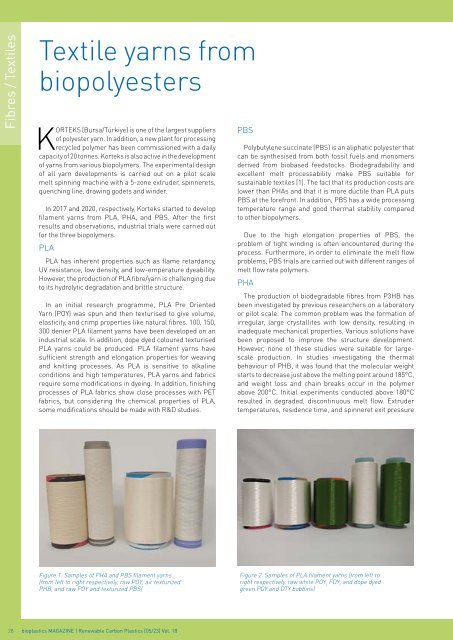Issue 05/2023
Highlights Fibres / Textiles Polyurethane / Elastomers
Highlights
Fibres / Textiles
Polyurethane / Elastomers
Create successful ePaper yourself
Turn your PDF publications into a flip-book with our unique Google optimized e-Paper software.
Fibres / Textiles<br />
Textile yarns from<br />
biopolyesters<br />
KORTEKS (Bursa/Türkiye) is one of the largest suppliers<br />
of polyester yarn. In addition, a new plant for processing<br />
recycled polymer has been commissioned with a daily<br />
capacity of 20 tonnes. Korteks is also active in the development<br />
of yarns from various biopolymers. The experimental design<br />
of all yarn developments is carried out on a pilot scale<br />
melt spinning machine with a 5-zone extruder, spinnerets,<br />
quenching line, drawing godets and winder.<br />
In 2017 and 2020, respectively, Korteks started to develop<br />
filament yarns from PLA, PHA, and PBS. After the first<br />
results and observations, industrial trials were carried out<br />
for the three biopolymers.<br />
PLA<br />
PLA has inherent properties such as flame retardancy,<br />
UV resistance, low density, and low-emperature dyeability.<br />
However, the production of PLA fibre/yarn is challenging due<br />
to its hydrolytic degradation and brittle structure.<br />
In an initial research programme, PLA Pre Oriented<br />
Yarn (POY) was spun and then texturised to give volume,<br />
elasticity, and crimp properties like natural fibres. 100, 150,<br />
300 denier PLA filament yarns have been developed on an<br />
industrial scale. In addition, dope dyed coloured texturised<br />
PLA yarns could be produced. PLA filament yarns have<br />
sufficient strength and elongation properties for weaving<br />
and knitting processes. As PLA is sensitive to alkaline<br />
conditions and high temperatures, PLA yarns and fabrics<br />
require some modifications in dyeing. In addition, finishing<br />
processes of PLA fabrics show close processes with PET<br />
fabrics, but considering the chemical properties of PLA,<br />
some modifications should be made with R&D studies.<br />
PBS<br />
Polybutylene succinate (PBS) is an aliphatic polyester that<br />
can be synthesised from both fossil fuels and monomers<br />
derived from biobased feedstocks. Biodegradability and<br />
excellent melt processability make PBS suitable for<br />
sustainable textiles [1]. The fact that its production costs are<br />
lower than PHAs and that it is more ductile than PLA puts<br />
PBS at the forefront. In addition, PBS has a wide processing<br />
temperature range and good thermal stability compared<br />
to other biopolymers.<br />
Due to the high elongation properties of PBS, the<br />
problem of tight winding is often encountered during the<br />
process. Furthermore, in order to eliminate the melt flow<br />
problems, PBS trials are carried out with different ranges of<br />
melt flow rate polymers.<br />
PHA<br />
The production of biodegradable fibres from P3HB has<br />
been investigated by previous researchers on a laboratory<br />
or pilot scale. The common problem was the formation of<br />
irregular, large crystallites with low density, resulting in<br />
inadequate mechanical properties. Various solutions have<br />
been proposed to improve the structure development.<br />
However, none of these studies were suitable for largescale<br />
production. In studies investigating the thermal<br />
behaviour of PHB, it was found that the molecular weight<br />
starts to decrease just above the melting point around 185°C,<br />
and weight loss and chain breaks occur in the polymer<br />
above 200°C. Initial experiments conducted above 180°C<br />
resulted in degraded, discontinuous melt flow. Extruder<br />
temperatures, residence time, and spinneret exit pressure<br />
Figure 1. Samples of PHA and PBS filament yarns<br />
(from left to right respectively, raw POY, air texturized<br />
PHB, and raw POY and texturized PBS)<br />
Figure 2. Samples of PLA filament yarns (from left to<br />
right respectively, raw white POY, FDY, and dope dyed<br />
green POY and DTY bobbins)<br />
28 bioplastics MAGAZINE | Renewable Carbon Plastics [<strong>05</strong>/23] Vol. 18

















